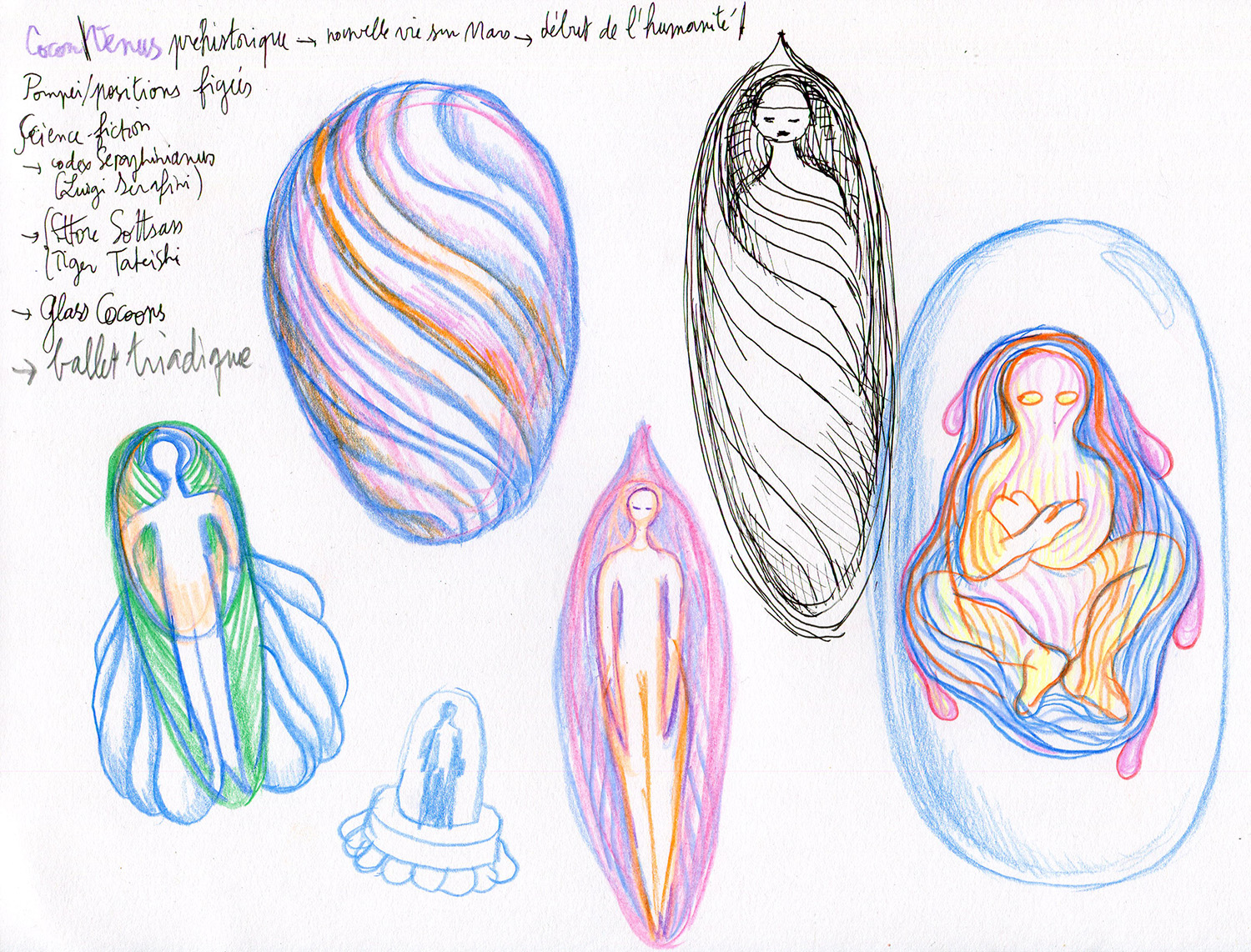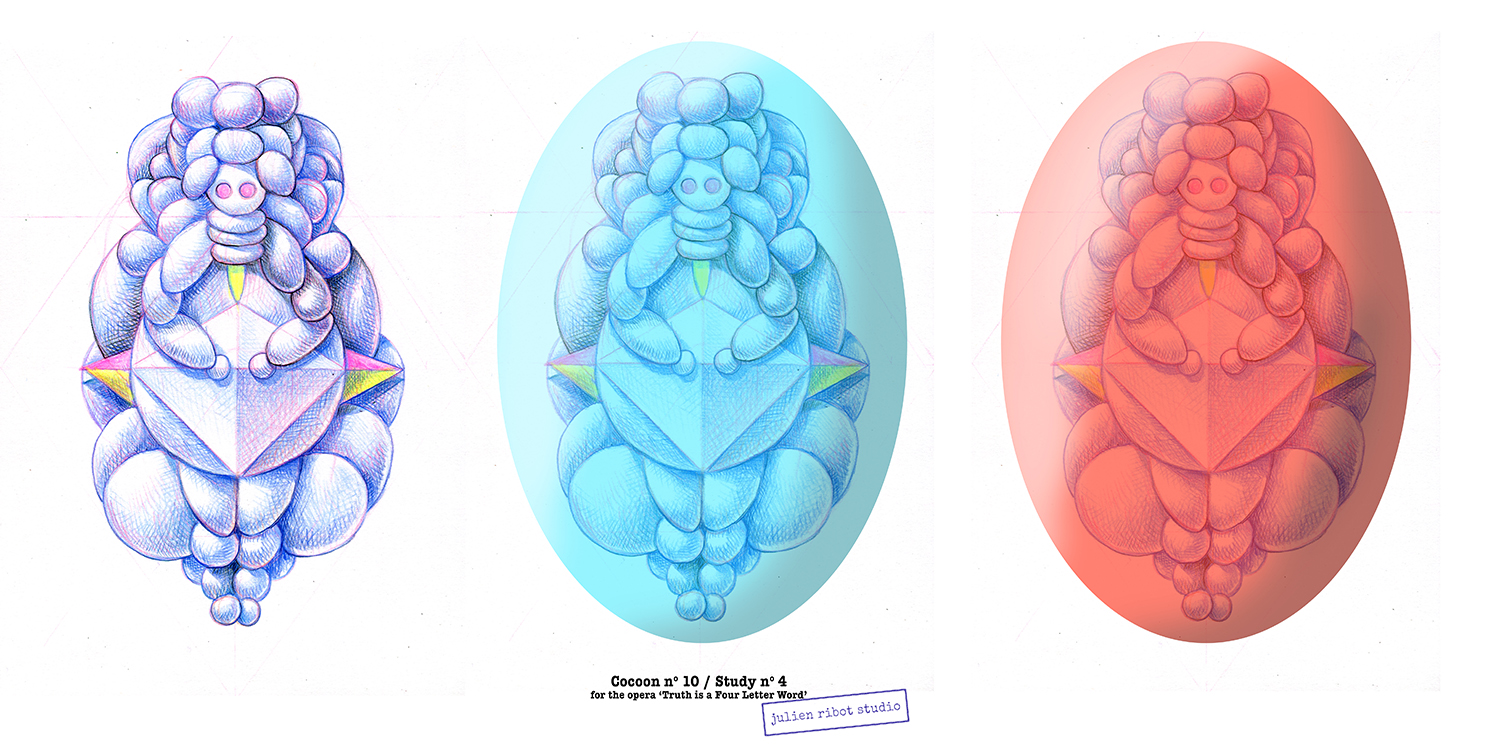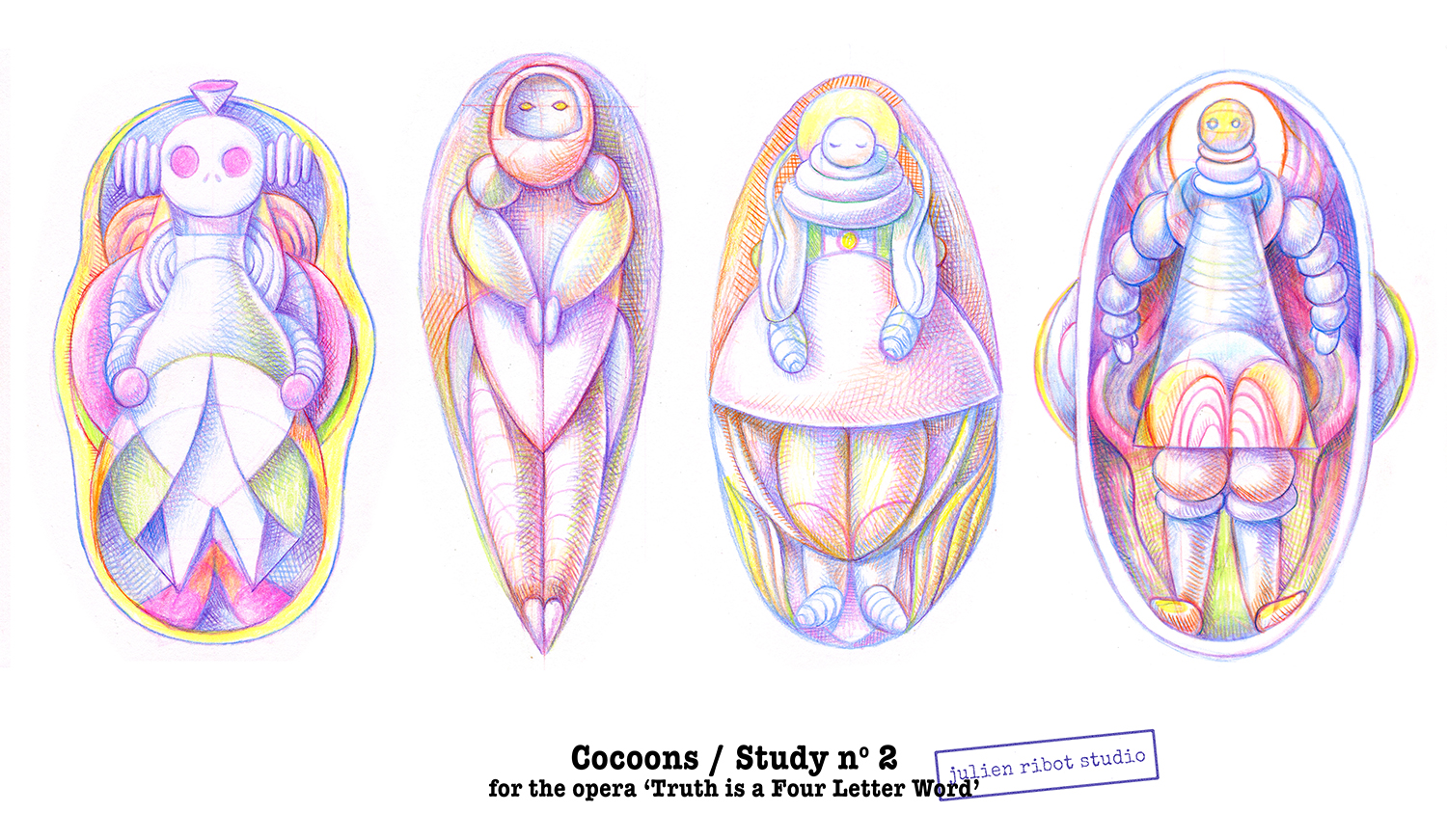journal de création
coulisses de la création
de TRUTH IS A FOUR-LETTER WORD
opéra de Fred Frith
Last year I was chatting to my brother Christopher on the phone when he said, a propos of nothing much, “maybe I should commission an opera from you”. I laughed and pointed out that this would, alas, involve rather a prohibitive budget, and we moved on to other things. The following morning I received an email from Fabien Simon, the director of the French festival Sons d’Hiver, proposing that they commission an opera. To say I was delighted and astonished, both by the commission and the serendipity, would be an understatement!
I asked my long-time compañera and co-conspirator Heike Liss, if she would be on board to do the scenography and we put our heads together, exchanged ideas, threw names around, and came up with a title: Truth is a Four Letter Word. In exploring initial ideas about the Theatre of the Absurd and our current post-truth universe I immediately thought of asking my friend, the French-Swiss writer and film-maker Julie Gilbert, for the libretto. She has created a wonderful kind of science fiction retelling of the story of Echo and Narcissus from the strangely distorted point of view of modern-day social media (and the apparent willingness of just about anyone to believe just about anything).
I’ve invited a fabulous line-up of some of my favorite musicians and singers to join us, all of whom touched me greatly by committing to the project without even asking about money! The group includes Lotte Anker (saxes), Alexandre Cahen (piano), Camille Emaille (percussion), Xavière Fertin (clarinets), Ada Gosling-Pozo (violin), Karoline Höfler (double bass), Garth Knox (viola), Ikue Mori (electronics), Tilman Müller (trumpet), Zeena Parkins (harp), Paula Sanchez (cello) and Gabriel Valtchev (tuned percussion), with Léopold Gilloots-Laforge (counter-tenor) and Alexia McBeth (mezzo-soprano).
L’année dernière, je discutais au téléphone avec mon frère Christopher lorsqu’il m’a dit, l’air de rien : « je devrais peut-être te commander un opéra ». J’ai ri et lui ai fait remarquer que cela impliquerait, hélas, un budget plutôt prohibitif, et nous sommes passés à autre chose. Le lendemain matin, j’ai reçu un courriel de Fabien Simon, le directeur du festival français Sons d’hiver, me proposant d’écrire un opéra. Dire que j’étais ravi et étonné, tant par la commande que par cet heureux hasard, serait un euphémisme !
J’ai demandé à ma compañera et co-conspiratrice de longue date, Heike Liss, si elle était d’accord pour s’occuper de la scénographie et nous avons commencé à réfléchir ensemble, échangé des idées, lancé des noms et trouvé un titre : Truth is a Four-Letter Word. En explorant de premières idées sur le théâtre de l’absurde et sur l’univers de post-vérité dans lequel nous baignons actuellement, j’ai immédiatement pensé à demander à mon amie, l’écrivain et cinéaste franco-suisse Julie Gilbert, d’écrire le livret. Elle a créé une merveilleuse version d’anticipation du mythe d’Echo et de Narcisse, du point de vue étrangement déformé des médias sociaux modernes (et de la propension apparente d’à peu près tout le monde de croire à peu près n’importe quoi).
Pour mener à bien cet opéra, j’ai constitué un groupe composé de certains de mes musiciennes et musiciens préférés, qui m’ont tous beaucoup touché en s’engageant dans le projet sans même demander combien ils allaient être payés ! Le groupe comprend Lotte Anker (saxes), Alexandre Cahen (piano), Camille Emaille (percussions), Xavière Fertin (clarinettes), Ada Gosling-Pozo (violon), Karoline Höfler (contrebasse), Garth Knox (alto), Ikue Mori (électronique), Tilman Müller (trompette), Zeena Parkins (harpe), Paula Sanchez (violoncelle) et Gabriel Valtchev (percussions accordées), avec le contre-ténor Léopold Gilloots-Laforge et la mezzo-soprano Alexia McBeth.
Fred Frith, California (USA), May 2022
fred frith, interview
What does it mean to you to make an opera? Is this the first time you’ve composed one?
That’s the question, isn’t it? Thirty years ago, I made Helter Skelter with “jeunes rockers au chômage des quartiers défavorisés” (de Marseille), but that was a collaboration with an existing theatre company and three professional singers, and my job was already quite clearly defined – and limited – by that particular situation. It was a wonderful experience and I learned a lot from it, and between then and now I’ve collaborated on Dropéra with Ferdinand Richard and written a couple of pieces for choirs, but this is really the first “traditional” opera I’ve been involved in.
What’s traditional about it?
Well I was not so much interested in being experimental, I wanted to explore the kind of story-telling that opera generally espouses. Julie’s libretto lends itself completely to a traditional musical approach and it’s been fun to play with that while dealing with a “science fiction” subject matter…
Science fiction?
Inasmuch as it’s set in the future, though the general plot-lines should be rather recognizably part of the current post-truth landscape!
And what’s the process? What have you and Heike been doing?
Well, first asking Julie (Gilbert) if she could imagine a story to fit the title we came up with – Truth is a Four-Letter Word. And when she wildly succeeded, I went to work on composing, which took several months. And meanwhile Heike was wrestling with everything else – direction, costumes, lighting, staging and seeing what was possible with our budget, and obviously waiting to see what I would do… It’s much clearer now that the music is finished, and we started some stripped-down rehearsals while we’ve been resident in Basel which have been really helpful (and enjoyable too, thanks also to the great crew of substitutes helping us out!) And then there have been all the crazy unforeseen dramas!
What dramas are you talking about?
Well first our counter-tenor realized after half a day’s rehearsal that he simply wasn’t a good fit for the role of Narcis, and by an amazing stroke of luck we found Léopold (Gilloots-Laforge) who came down from Paris the very next day and rehearsed with us for three days as if he was born for the part! And then, believe it or not, our mezzo-soprano had to leave the team for entirely understandable but unexpected reasons, and again, we were extraordinarily lucky to be able to welcome Alexia (MacBeth) to play Echo. Which was great but all a bit of a roller-coaster! And along the way the sound designer had to leave us, but found a very strong replacement, same story with the lighting designer. And to round out the story Dirk Schulz, a theatre director who lives in Basel came round to our place to give us the benefit of his experience (since we didn’t really have any expertise in this field) and somehow became Heike’s co-director – lucky us! It was the final piece of the puzzle…
Tell me about the ensemble, who’s involved?
Well for many years I’ve had a group called The International Occasional Ensemble, and it’s always open and changing according to the context, but at this point it feels like a family – which obviously makes working together productive and focused. It really helps to collaborate with people who understand how I think and how I work, and who are not afraid to question things if they need questioning! Some of these players are old friends – Ikue Mori, Zeena Parkins, Lotte Anker, Tilman Müller, Garth Knox; some like Karoline Höfler and Ada Gosling-Pozo have been involved in many of my film sound track recordings; and some are connections I made while teaching in Basel – Camille Émaille, Xavière Fertin, Alexandre Cahen. Gabriel Valtchev is the only one who I never worked with before but he already fits in perfectly!
The fact that we have such a wide range of ages and experiences is beautiful. I should add that I will also play myself, so I hope I won’t feel like I’m wearing too many hats!
How do you mean?
Well, the roles of player, composer, conductor all demand different kinds of attention and concentration. But knowing that Heike and Dirk are in charge of the production lightens my load considerably.
Faire un opéra, qu’est-ce que cela signifie pour vous ? Est-ce la première fois que vous en composez un ?
Il y a trente ans, j’ai fait Helter Skelter avec des jeunes rockers au chômage des quartiers défavorisés de Marseille, mais il s’agissait d’une collaboration avec une compagnie de théâtre existante et trois chanteurs professionnels, et mon travail était déjà assez clairement défini – et limité – par cette situation particulière. C’était une expérience merveilleuse et j’ai beaucoup appris. Entre-temps, j’ai collaboré à Dropéra avec Ferdinand Richard et écrit quelques pièces pour chœurs, mais c’est vraiment le premier opéra “traditionnel” auquel je participe.
« Traditionnel », c’est-à-dire ?
Je n’étais pas tellement intéressé ici par l’expérimentation, je voulais explorer le type de narration que l’opéra préconise généralement. Le livret de Julie Gilbert se prête parfaitement à une approche musicale traditionnelle et c’était amusant de jouer avec cela tout en traitant un sujet de “science-fiction”…
Science-fiction ?
Dans la mesure où l’histoire se déroule dans le futur, même si les grandes lignes de l’intrigue devraient pouvoir être reconnues dans le paysage actuel de post-vérité !
Quel a été le processus de travail pour Heike et toi ?
J’ai d’abord demandé à Julie (Gilbert, ndlr) si elle pouvait imaginer une histoire correspondant au titre que nous avons trouvé – Truth is a Four-Letter Word. Et quand elle a réussi, je me suis mis au travail pour composer, ce qui a pris plusieurs mois. Pendant ce temps, Heike se débattait avec tout le reste : mise en scène, costumes, éclairages, tout en étudiant ce qui était possible avec le budget. C’est beaucoup plus clair maintenant que la musique est terminée, et nous avons commencé quelques répétitions dépouillées pendant que nous étions en résidence en Suisse à Bâle, ce qui a été très utile. Ensuite il y a eu tous les « drames » imprévus !
De quels « drames » parlez-vous ?
Tout d’abord, le contre-ténor initial s’est rendu compte après une demi-journée de répétition qu’il n’était pas fait pour le rôle de Narcisse. Par un coup de chance incroyable, nous avons rencontré Léopold (Gilloots-Laforge, ndlr) venu de Paris dès le lendemain et a répété avec nous pendant trois jours comme s’il était né pour le rôle ! Et puis, croyez-le ou non, la mezzo-soprano a dû quitter l’équipe, et là encore, nous avons eu la chance extraordinaire de pouvoir accueillir Alexia (MacBeth, ndlr) pour jouer Echo. C’était génial, mais c’était un peu les montagnes russes ! En cours de route, l’ingénieur du son a dû nous quitter, mais il a trouvé un très bon remplaçant, tout comme la créatrice lumières. Et pour finir, Dirk Schulz, un metteur en scène de théâtre qui vit à Bâle, est venu chez nous pour nous faire profiter de son expérience (puisque nous n’en avions pas vraiment) et est devenu en quelque sorte le codirecteur de Heike – quelle chance ! C’était la dernière pièce du puzzle.
Comment as-tu composé le groupe de musicien.ne.s ?
Depuis de nombreuses années, j’ai un groupe appelé The International Occasional Ensemble. Il est ouvert mais à ce stade, c’est comme une famille – ce qui facilite le travail commun. C’est très utile de collaborer avec des personnes qui comprennent ma façon de penser et de travailler, qui n’ont pas peur de remettre les choses en question au besoin. Certains de ces musiciens sont de vieux amis : Ikue Mori, Zeena Parkins, Lotte Anker, Tilman Müller, Garth Knox. D’autres, comme Karoline Höfler et Ada Gosling-Pozo, ont participé à plusieurs de mes enregistrements de bandes originales de films. D’autres encore sont des contacts noués quand j’enseignais à Bâle : Camille Émaille, Xavière Fertin, Alexandre Cahen. Je n’avais jamais travaillé avec Gabriel Valtchev mais il s’est déjà parfaitement intégré au projet ! Le fait que nous ayons un tel éventail d’âges et d’expériences est magnifique. Je dois ajouter que je jouerai aussi moi-même, j’espère juste que je n’aurai pas l’impression de porter trop de chapeaux !
Comment ça ?
Être musicien, compositeur et chef d’orchestre exige différents types d’attention et de concentration. Mais savoir que Heike et Dirk sont au travail allège considérablement ma charge.
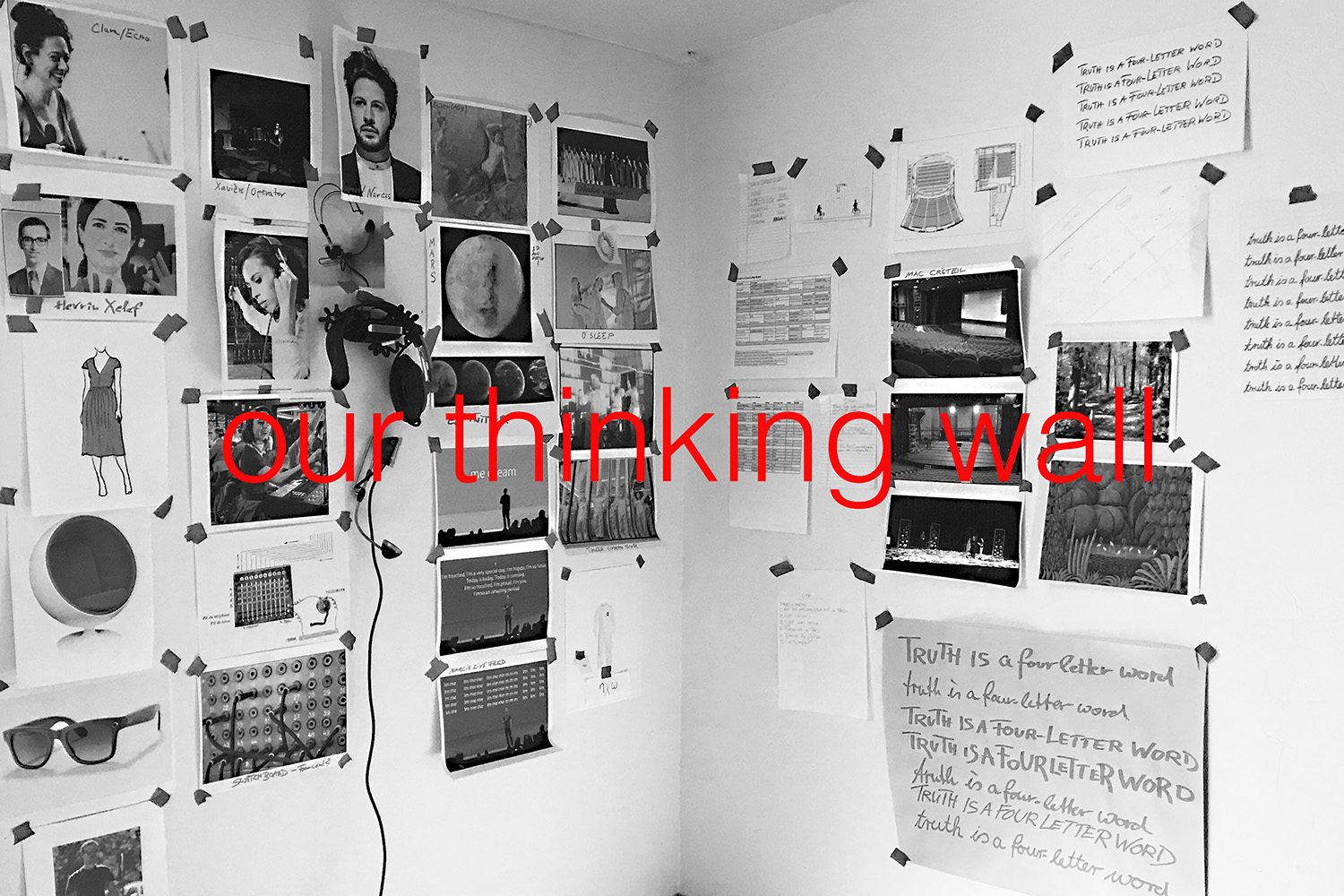
Fred Frith’s office
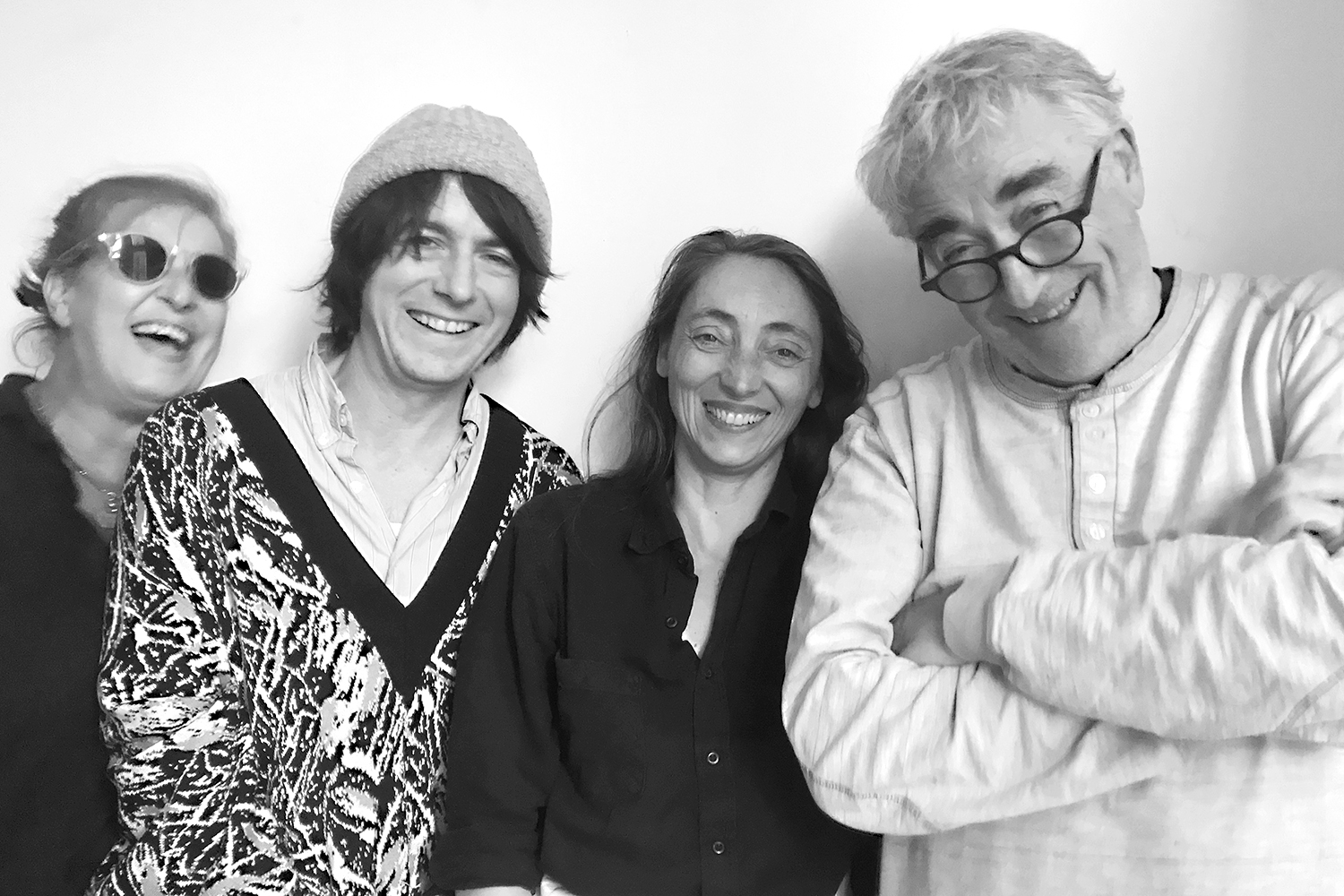
Heike Liss, Julien Ribot, Julie Gilbert & Fred Frith
There’s also video, right?
Yes, both Heike and Julien Ribot will be contributing very different kinds of video material. We saw Julien’s work when we were both performing at the Villa Medici in Rome a few years ago, and fell in love with it, so we’re excited to see what he comes up with. And Heike is going to be shooting some video for the Collectif Echo scenes when we get back to California. She and I have been performing Drawing Sound together for many years now and I’m curious to see how or if that experience will impact this material.
So, tell me about the music. How did you set about composing?
Actually, I started with interludes – I was scheduled to perform with Zeena (Parkins) at a festival at Mills College, and I composed a series of pieces for harp and electric guitar with half a mind on the idea that they could be used in the opera, so before I even received the libretto I had that material. After that I tackled the sections that had something in common – the Collectif Echo scenes, or Narcis live streaming – because they needed to hang together thematically, and slowly it all took shape. I started in March and it was pretty much done by the end of August. Obviously, the Overture was the last thing to be composed because you can’t write an overture without knowing what all the thematic strands are going to be! And the dream sequence was challenging because there are NO thematic connections at all, it’s in the form of a collage with a lot of different compositional approaches. But I must say the whole process was nothing if not fun!
Anything else you want to say?
Well, we’re extremely happy with the team in Paris – the folks from Sons d’hiver festival and also the theatre in Créteil have been incredibly generous and supportive. It’s been great actually!
Il y a aussi de la vidéo dans cet opéra ?
Oui, Heike et Julien Ribot fourniront tous deux du matériel vidéo de types très différents. Nous avons vu le travail de Julien lorsque nous étions avec Heike sur scène à la Villa Médicis à Rome il y a quelques années, et nous en sommes tombés amoureux, nous sommes donc impatients de voir ce qu’il va nous proposer. Et Heike va tourner quelques vidéos pour les scènes du Collectif Echo quand nous serons de retour en Californie. Elle et moi avons joué ensemble dans le duo Drawing Sound pendant de nombreuses années maintenant et je suis curieux de voir comment ou si cette expérience aura un impact sur ce matériel.
Parlons musique. Comment as-tu procédé pour l’écriture ?
En fait, j’ai commencé par des interludes – il était prévu que je me produise avec Zeena (Parkins, ndlr) lors d’un festival au Mills College, et j’ai composé une série de morceaux pour harpe et guitare électrique en ayant à l’esprit qu’ils pourraient être utilisés dans l’opéra, donc avant même de recevoir le livret, j’avais ce matériel. Ensuite, je me suis attaqué aux sections qui avaient quelque chose en commun – les scènes du Collectif Echo, ou le live-streaming de Narcisse – parce qu’il fallait qu’elles se rejoignent sur le plan thématique, et petit à petit, tout a pris forme. J’ai commencé en mars dernier et tout était pratiquement terminé à la fin du mois d’août. Évidemment, l’ouverture de l’opéra a été la dernière chose à être composée, car on ne peut pas écrire une ouverture sans savoir quels seront les thèmes abordés ! Et la séquence de rêve était un défi car il n’y a AUCUN lien thématique, c’est une sorte de collage avec beaucoup d’approches compositionnelles différentes. Mais je dois dire que tout le processus a été très amusant !
Quelque chose à ajouter ?
Eh bien, nous sommes extrêmement heureux de l’équipe à Paris – les gens du festival Sons d’hiver et de la Maison des Arts de Créteil ont été incroyablement généreux et nous ont vraiment soutenus. C’est vraiment génial !
retour
au menu
julie gilbert, notes
Le 5 septembre 2021, j’ai reçu ce mail dans ma boîte de Fred Frith qui me disait qu’il voulait faire un opéra sur la post-vérité.
Le mot post-vérité a fait surgir de façon disparate les tweets de Trump, les fake news, les faits divers, une avalanche de matériau disparate, dont on ne connait pas encore tout à fait l’impact sur nos sociétés. La post-vérité est finalement une notion très récente – en 2016, c’est le mot de l’année – et on pourrait la définir comme : « des circonstances dans lesquelles les faits objectifs ont moins d’influence pour former l’opinion publique que l’appel à l’émotion et aux croyances personnelles » (Oxford English Dictionary). On a alors échangé avec Fred sur ce qui pouvait relever de la post-vérité, en partageant des réflexions et des textes de Timothy Snyder, Carl Sagan, Hannah Arendt, Phillip K Dick, Alain Damasio ou Ursula Le Guin. La question était donc : comment raconter une histoire qui raconte la post-vérité. Comment parler de ce qui nous arrive ?
Au moment d’écrire, j’étais intéressée par la légende d’un roi portugais, Sébastien 1er, disparu étrangement lors d’une bataille de 1578 ainsi que par le fait divers sur le californien Jeffrey Lash, qui disait être agent secret extraterrestre.
La question du récit est au centre de la fabrication de la post-vérité. En quoi ce qui est raconté par une seule personne prend forme dans le réel et créé une réalité. Je cherchais donc une légende, comme les services secrets en fabriquent, une légende liée au déni de la tragédie écologique.
Mais en assistant à une discussion de l’historien Hervé Mazurel, qui disait que nous étions passés d’une société d’Œdipe à une société de Narcisse, il m’est apparu alors évident que Narcisse était le héros parfait d’une histoire au temps de la post-vérité.
C’est-à-dire le héros non plus d’une société de l’héritage mais d’une société de l’immédiateté. Non plus d’une société du commun, mais d’une société de l’individu.
On September 5, 2021, I received this email in my inbox from Fred Frith telling me that he wanted to make an opera about post-truth.
The word post-truth conjured up Trump’s tweets, fake news, news stories, an avalanche of disparate material, the impact of which on our societies is not yet fully known. Post-truth is ultimately a very recent notion—in 2016, it was the word of the year—and could be defined as: “Circumstances in which objective facts are less influential in shaping public opinion than appeals to emotion and personal belief” (Oxford English Dictionary). We then exchanged with Fred on what could be considered post-truth, sharing reflections and texts from Timothy Snyder, Carl Sagan, Hannah Arendt, Phillip K. Dick, Alain Damasio or Ursula Le Guin. The question was thus: how to tell a story that addresses post-truth. How to talk about what is happening to us?
At the time of writing, I was interested in the legend of a Portuguese king, Sebastian I, who mysteriously vanished during a battle in 1578, as well as in the news story about the Californian Jeffrey Lash, who claimed to be a secret extraterrestrial agent.
The question of storytelling is central to the manufacture of post-truth. How what is told by a single person takes shape in real life and creates a reality. So I was looking for a legend, like those created by secret services, a legend related to the denial of the ecological tragedy.
But when I attended a discussion by historian Hervé Mazurel, who said that we had gone from an Oedipus society to a Narcissus society, it became clear to me that Narcissus was the perfect hero for a story in the post-truth era.
That is to say, the hero no longer of a society of legacy but of a society of immediacy. No longer of a society of the collective, but of a society of the individual.
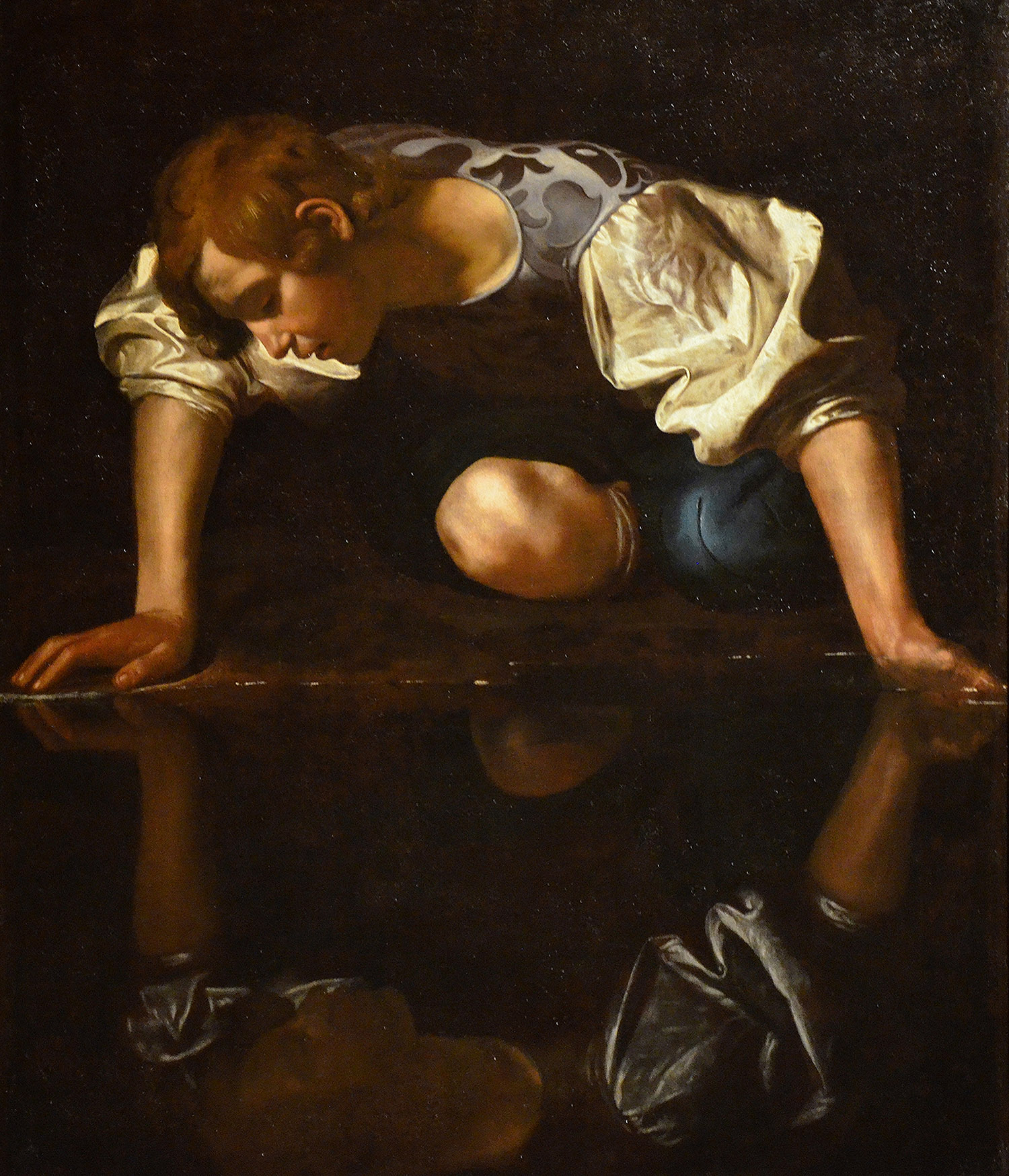
Narcissus © Caravaggio (circa 1597–1599)
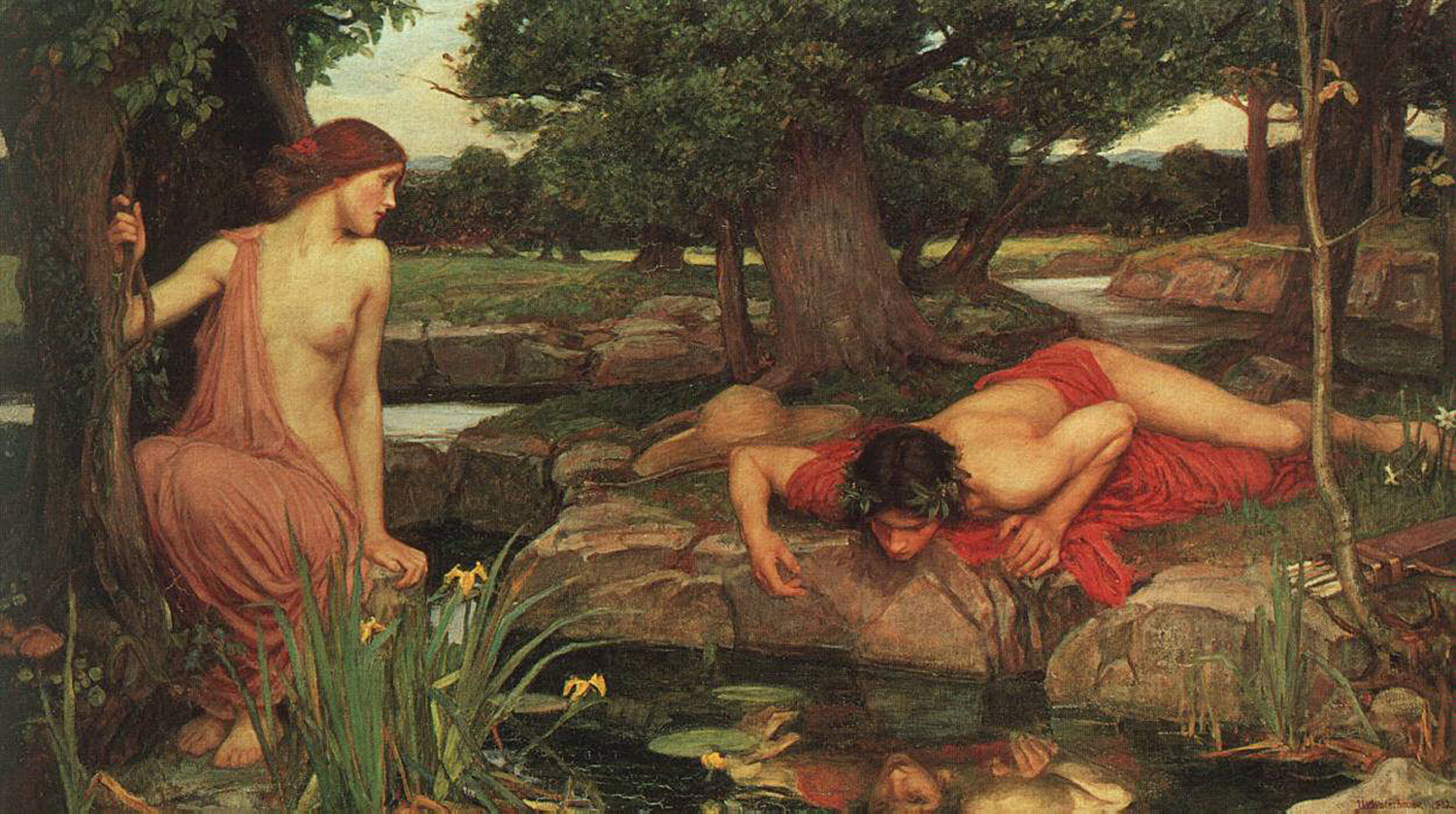
Echo and Narcissus © John William Waterhouse
SpaceX in Mars

I IM
Im me Immeme Im me Immeme Im me Immeme Im me Immeme Im me Immeme
Im mememmm Im mememmm Im mememmm Im mememmm Im mememmm
Im Im Im Im Im Im Im Im Im Im Im Im Im Im Im
Narcis
Il se trouve que je vivais à ce moment-là dans un appartement juste en-dessous d’un youtuber dont je voyais les live et vidéos réalisés chez lui sur les applis mais avec qui je n’avais aucun contact réel. A ce moment-là aussi j’avais vu la vidéo d’Elon Musk de son projet sur Mars où on voit une cité nouvelle sous cloche, des maisons futuristes et des humain·e·s qui déambulent heureux et heureuses dans ce monde fabriqué de toute pièce.
« Je pense qu’il y a vraiment deux chemins fondamentaux. L’Histoire est en train de bifurquer dans deux directions. Un chemin est que nous restions sur Terre pour toujours, avec l’éventualité qu’un évènement d’extinction survienne (…) L’alternative est de devenir une civilisation spatiale et une espèce multi-planétaire qui, j’espère, vous convient comme chemin à parcourir. » (Elon Musk, revue New Space)
La conjonction de ces deux événements a fait naître pour ce livret un Narcisse contemporain enfermé dans le monde virtuel et travaillant au bien de l’humanité à partir d’une croyance ne reposant sur aucune réalité.
Car qu’est-ce que la post-vérité si ce n’est une vérité flottante, non ramifiée, non reliée à des faits prouvés, réels. Dans cette vérité sans socle, non validée par aucune communauté historique ou scientifique, tout devient éternellement possible et rend totalement impossible toute contre-vérité. La post-vérité ressemble à une hypnose. C’est le sommeil de la raison… qui engendre des monstres.
I happened to be living at that time in an apartment just below a YouTuber whose lives and videos I watched at home on apps but with whom I had no real contact. At that time I had also seen Elon Musk’s video of his project on Mars showing a new city under a bell, futuristic houses and humans strolling happily in this fabricated world.
“I think there are really two fundamental paths. History is branching out in two directions. One path is for us to stay on Earth forever, with the possibility of an extinction event occurring (…) The alternative is to become a space-faring civilization and a multi-planetary species which I hope you’re comfortable with as a path to travel.” (Elon Musk, New Space magazine.)
The conjunction of these two events has given birth for this libretto to a contemporary Narcissus locked in the virtual world and working for the good of humanity on the basis of a belief that is not grounded in any reality.
For what is post-truth if not a floating truth, unbranched, not linked to proven, real facts. In this truth without foundation, not validated by any historical or scientific community, everything becomes eternally possible and makes any untruth totally impossible. Post-truth is like hypnosis. It is the slumber of reason… which creates monsters.
NARCIS
Bienvenue Echo dans Me-Dream
ECHO
Me-Dream
NARCIS
Toi aussi tu veux rêver ?
ECHO
Rêver…
NARCIS
Devenir quelqu’un d’autre ? Un homme ?
Un enfant ?
Un aigle ? Briller ?
Le pouvoir ? Une femme puissante…?
ECHO
Une femme puissante…
NARCIS
Je savais que tu voulais ça
Dans le mythe originel, Héra accuse Echo d’aimer Zeus et punit Echo en la privant de sa capacité de parler, lui permettant juste de répéter les derniers mots qui lui sont adressés. Plus tard, Echo tombe éperdument amoureuse de Narcisse mais ne peut lui dire son amour. Rejetée par celui-ci, elle dépérit. La déesse Némésis, touchée par le destin de la nymphe, décide alors de la venger et rend Narcisse obsédé à en mourir par sa propre image dans l’eau d’une fontaine.
Dans la ré-écriture de cette histoire, j’ai gardé le rejet du réel, la peur du réel par Narcisse qui refuse d’être touché, abîmé et même aimé par Echo, une réaction que je pouvais relier aux relations via les réseaux sociaux.
Mais à l’inverse du mythe, j’utilise l’écho comme un cheval de Troie. Narcisse ne voulant entendre que son propre discours, ne s’aimant que lui-même, tant qu’Echo est un double de lui, il la veut, car elle co-construit sa vérité, mais à partir du moment où elle reprend sa voix – celle du Collectif ECHO, il la rejette.
NARCIS
L’être humain n’a pas besoin de soleil
Il a besoin d’une source de lumière
L’air de nos villes est irrespirable
Celui que nous offrons
Est celui des glaciers
Tu as changé Echo
ECHO
Pourquoi abandonner ce qu’on a pour une fiction qu’on ne connaît pas ?
NARCIS
Tu es mal informée Echo
La fable imaginée permet de mettre en scène l’oppression générée par un pouvoir usant de ces vérités fluctuantes et la possibilité néanmoins d’une lutte pour se réapproprier notre capacité d’être au monde et notre propre récit.
Le collectif ECHO lutte pour une vérité commune, pour un récit de chair, lutte pour le réel qu’on a, plutôt que le virtuel qu’on n’a pas. C’est aussi une lutte de la langue. «L’effritement du langage correspond à un effritement de la pensée», comme disait Marguerite Yourcenar*. Echo et le collectif ECHO sont attachés aux mots dans le sens où les mots créent notre réalité, tandis que Narcisse utilise les mots pour créer de l’émotion, peu importe leur vérité.
NARCIS
Welcome Echo in Me-Dream
ECHO
Me-Dream
NARCIS
Do you want to dream too?
ECHO
Dream…
NARCIS
To become someone else? A man? A Child? An Eagle? To shine? Power? A powerful woman…?
ECHO
A powerful woman…
NARCIS
I knew you wanted this
In the original myth, Hera accuses Echo of loving Zeus and punishes Echo by depriving her of her ability to speak, only allowing her to repeat the last words spoken to her. Later, Echo falls madly in love with Narcissus but cannot tell him her love. Spurned by him, she withers away. The goddess Nemesis, touched by the fate of the nymph, decides to avenge her and makes Narcissus obsessed to death by his own image in the water of a fountain.
Rewriting this story, I kept the rejection of reality, the fear of reality by Narcissus who refuses to be touched, damaged and even loved by Echo, a reaction that I could link to relationships via social networks.
But unlike the myth, I use the echo as a Trojan horse. Narcissus only wants to hear his own speech, only loving himself, as long as Echo is a double of him, he desires her, because she co-constructs his truth, but from the moment she reclaims her voice—that of the ECHO Collective, he rejects her.
NARCIS
Human beings do not need the sun
They need a source of light
The air of our cities is unbreathable
The one we offer
Is that of the glaciers
You have changed Echo
ECHO
Why give up what we have for a fiction we don’t know?
NARCIS
You are misinformed Echo
The imagined fable lets us stage the oppression generated by a power using these fluctuating truths and the possibility yet of a struggle to reappropriate our capacity to be in the world and our own narrative.
The ECHO collective fights for a common truth, for a narrative of flesh, fights for the real we have, rather than the virtual we don’t. It is also a struggle for language.
As Marguerite Yourcenar* said: “The crumbling of language goes hand in hand with the crumbling of thought”. Echo and the ECHO collective are attached to words in the sense that words create our reality, while Narcisse uses words to create emotion, regardless of their truth.
*Marguerite Yourcenar.
Femme d’Aujourd’hui, 27 mai 1975
ECHO
Narcis !
Narcis…
Narcis…
Narcisio
No te vayas
Escuchame
Lo que quieres
es fuego sin fuego
es amor sin cuerpo
besos sin saliva
¿qué harás con las cosas olvidadas?
Frémissement
Nuit d’été
Vent
Lichens
Poussière
Baiser
Mousse
Autoroutes
Rosée
Vélomoteur
Néons verts
¿Qué haras de nuestros cuerpos?
Del esperma
De la menstruación
Del sudor
De la muerte
La commande de l’opéra était de deux personnages, un homme et une femme. Mais il m’a semblé nécessaire, pour éviter l’esthétique plate des réseaux sociaux et le duel des personnages, d’incarner l’assistante qui est une intelligence digitale de Narcisse à travers une icône vintage de l’opératrice du début de la téléphonie. L’extériorisation du personnage permet aussi de raconter la façon dont Narcisse fait corps avec son projet Me-Dream.
Le personnage d’Echo se dédouble, devient même triple, permettant par cette multiplicité de rendre compte aussi de cette possible multiplication des identités dans le virtuel. Echo qui fait partie du collectif de lutte ECHO, adopte une identité fabriquée pour infiltrer Me-Dream, mais progressivement, en tombant amoureuse de Narcisse, elle apparaît telle qu’elle est : une militante d’origine latino-américaine.
Finalement, en explorant le mythe de Narcisse et Echo, je voulais aussi faire référence aux opéras classiques qui sont souvent des histoires d’amour impossible. Ici il s’agit d’une histoire d’amour dans un monde de la post-vérité. C’est-à-dire une histoire d’amour dans un monde où plusieurs vérités, plusieurs corporalités se côtoient. L’amour dans ce cas est au risque du réel, au risque d’une vérité commune, au risque d’un engagement commun. Donc une histoire politique.
Ecriture du livret – réflexions, notes
Julie Gilbert
Décembre 2022
ECHO
Narcis!
Narcis…
Narcis…
Narcisio
No te vayas
Escuchame
Lo que quieres
es fuego sin fuego
es amor sin cuerpo
besos sin saliva
¿qué harás con las cosas olvidadas?
Shudder
Summer night
Wind
Lichens
Dust
Kiss
Moss
Highways
Dew
Moped
Green neon
¿Qué haras de nuestros cuerpos?
Del esperma
De la menstruación
Del sudor
De la muerte
The opera commission was for two characters, a man and a woman. But it seemed necessary to me, in order to avoid the flat aesthetics of social networks and the duel of the characters, to portray the assistant who is a digital intelligence of Narcisse through a vintage icon of the early telephone operator. The externalization of the character also allows us to tell the story of how Narcisse becomes one with his Me-Dream project.
The Echo character splits in two, three even, allowing through this multiplicity to also account for this possible multiplication of identities in the virtual. Echo, who is part of the militant collective ECHO, adopts a fabricated identity to infiltrate Me-Dream, but gradually, by falling in love with Narcissus, she appears as she truly is: an activist of Latin American origin.
Finally, in exploring the myth of Narcissus and Echo, I also wanted to reference classical operas, which are often stories of impossible love. In this case, it is a love story in a post-truth world. That is to say, a love story in a world where several truths, several physicalities, exist side by side. Love in this case is at the risk of reality, at the risk of a common truth, at the risk of a common commitment. Thus a political story.
Writing the libretto—thoughts, notes
Julie Gilbert
December 2022
retour
au menu
Heike Liss, mise en scène
It seems like your role has been steadily expanding in the months since you were first named as being responsible for “scenography”. Can you talk a little bit about the process?
Once I had read the libretto and started thinking about the scenography—which I understood from the beginning would include video projections from Julien Ribot and myself—I quickly realized that I had much more on my plate than that: costumes, props, make-up, and an overall visual concept and dramaturgy. My job title changed from “scenographer” to “artistic director” and that brought even more tasks and responsibilities with it. When it came to creating a director’s book I knew I needed help, and reached out to theatre director Dirk Schulz whom I knew a little bit from our time in Basel. A few days later Fred, Dirk and I had our first meeting. Dirk was generous, patient, enthusiastic, funny. And his input and feedback were fantastic. I suggested that he join the team as my “co-director”. Since then the two of us have been happily collaborating.
What does collaboration look like? Do you have clearly defined roles beyond creating a director’s book, or is it pretty fluid?
We are truly collaborating and don’t have clearly defined roles. But we are aware of our different skillsets, strengths and weaknesses and make use of that when we divide tasks among us. Mostly we have short and long meetings in person or on the phone in which we throw ideas back and forth, research, talk, think, rethink, and argue until we agree and then dive back into getting the jobs done.
Il semble que ton rôle dans la création de l’opéra, d’abord réservé à la scénographie, n’ait cessé de s’amplifier au fil des mois. Peux-tu nous parler un peu de comment les choses ont évolué ?
Quand j’ai lu le livret de Julie Gilbert et que j’ai commencé à penser à la scénographie — dont j’ai compris dès le début qu’elle inclurait des projections vidéo de Julien Ribot et de moi-même — j’ai rapidement réalisé que j’avais beaucoup plus à faire que cela : costumes, accessoires, maquillage, concept visuel global et dramaturgie. Mon rôle est donc passé de “scénographe” à “directrice artistique”, ce qui a entraîné encore plus de tâches et de responsabilités. Lorsqu’il a fallu créer un cahier des charges pour la scénographie et la mise en scène, je savais que j’avais besoin d’aide et j’ai alors contacté le metteur en scène Dirk Schulz, que je connaissais un peu depuis notre séjour à Bâle. Quelques jours plus tard, Fred, Dirk et moi avons eu notre première rencontre. Dirk a été généreux, patient, enthousiaste et drôle. Et sa contribution et ses retours étaient fantastiques. Je lui ai proposé de rejoindre l’équipe en tant que “codirecteur artistique”. Nous collaborons désormais tous les deux avec plaisir.
À quoi ressemble la collaboration ? Avez-vous des rôles clairement définis au-delà de la création d’un cahier des charges, ou est-ce plutôt fluide ?
Nous collaborons réellement et n’avons pas de rôles clairement définis. Mais nous sommes conscients de nos différentes compétences, de nos forces et de nos faiblesses et nous en tenons compte lorsque nous nous répartissons les tâches. La plupart du temps, nous tenons des réunions, en personne ou au téléphone, au cours desquelles nous lançons des idées, effectuons des recherches, discutons, réfléchissons, repensons et discutons jusqu’à ce que nous soyons d’accord, puis nous nous remettons au travail.
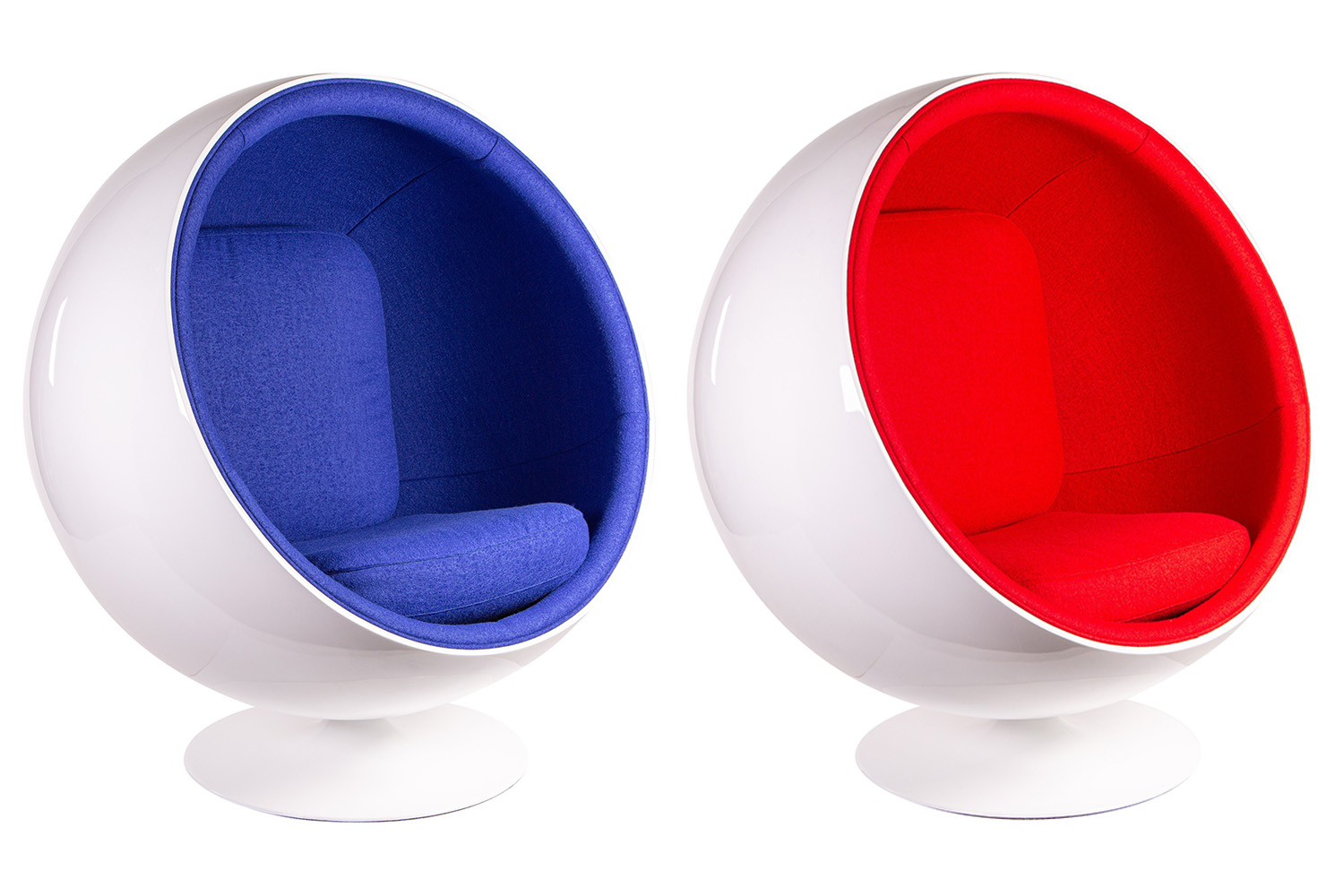
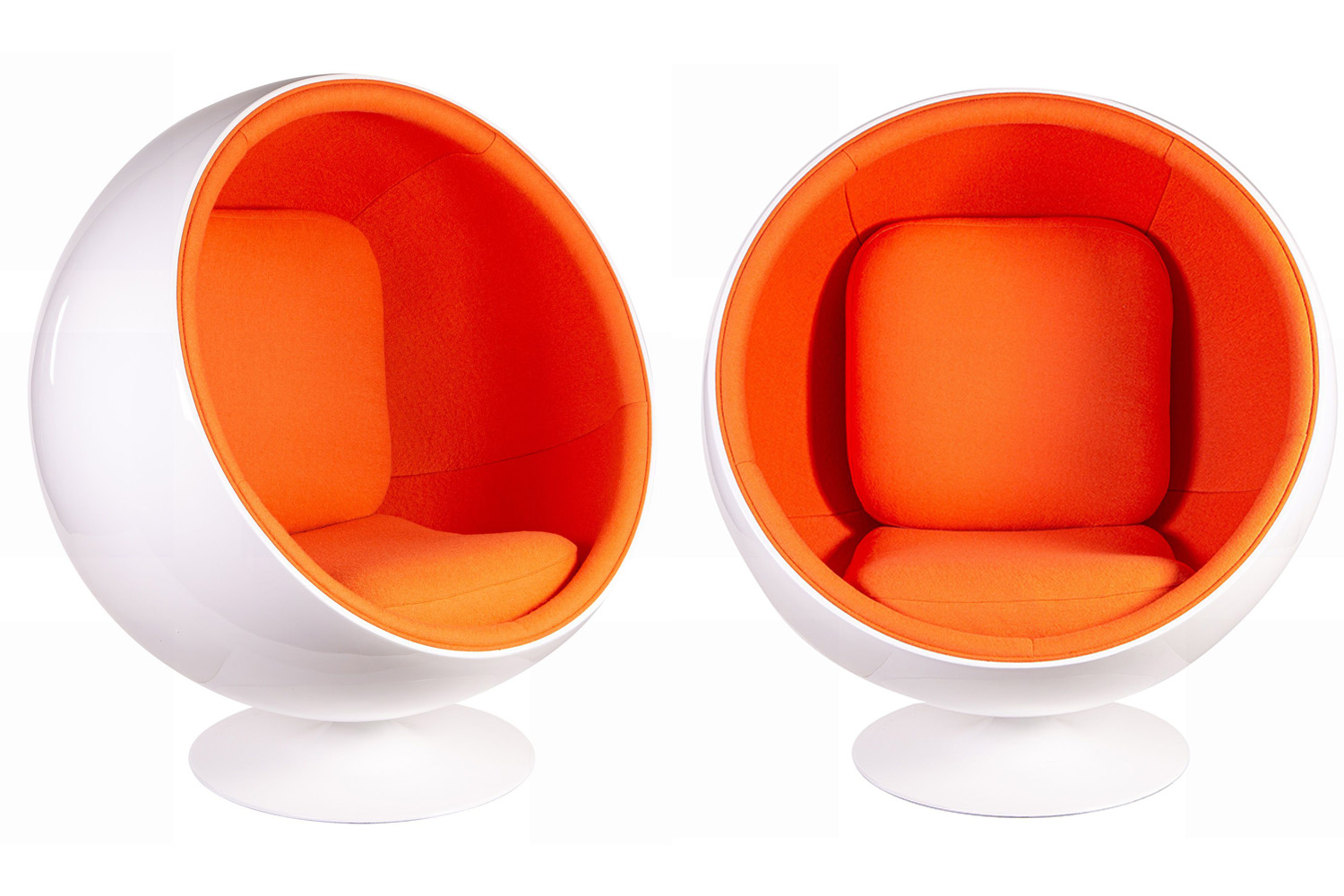
*Exemple d’accessoire “Ball Chairs” © Arne Jacobsen
One characteristic of the libretto is that it is set in the future but also draws heavily on the past, in the protagonist’s memory, for example. How did you approach that particular challenge?
It is our goal to realize Julie’s vision and Fred’s musical interpretation of the story. We constantly communicate with both of them about small details as well as the big picture. We are going for a set that is minimalistic, which means every item on stage counts and has to be just right. Hunting down the perfect prop* or costume can take hours, days, weeks, especially when they are from the past and the future (what does that even look like?). We have a lot of help from Sons d’Hiver who are looking directly in Paris, but we also have to design, build, make – which is difficult given that we are physically far away from the stage as well as the singers. Especially on a tight budget. What did Andrée Putman say? ”Style has nothing to do with money. In fact, an excess of money can handicap style. It doesn’t help to have so much choice.” Right!
You were both present in the early rehearsals in Basel, quite actively involved. Do you have any impressions as to how the music is developing?
Being at the rehearsals was crucial for our work. Experiencing the music and the atmosphere it evokes gave us new and sometimes surprising ideas. It also answered many design and lighting questions. And we had the possibility to start working with the singers on dramaturgy, acting and emotions which in return had an impact on the instructions for the musicians and sometimes even the composition. Fred would go home to re-write a part based on our observations and comments, we would go home, talk to Julie and then re- think the color of a backdrop or the content of a video, or a costume. It all really hangs together. It is a beautiful thing.
January, 2023
L’une des caractéristiques du livret est qu’il se déroule dans le futur, mais qu’il fait aussi largement appel au passé, dans la mémoire du protagoniste principal, par exemple. Comment avez-vous abordé ce défi particulier ?
Notre objectif est de concrétiser la vision et l’interprétation musicale de l’histoire de Julie et Fred. Nous communiquons constamment avec eux sur les petits détails et les grandes lignes. Nous avons opté pour un décor minimaliste, ce qui signifie que chaque élément sur scène compte et doit être parfait. La recherche de l’accessoire* ou du costume parfait peut prendre des heures, des jours, des semaines, surtout lorsqu’il s’agit d’objets du passé ou du futur (à quoi cela ressemble-t-il?). Nous avons beaucoup d’aide à ce niveau de la part du festival Sons d’hiver qui regarde directement à Paris, mais nous devons aussi concevoir, construire, fabriquer — ce qui est compliqué sachant que nous sommes physiquement éloignés de la salle qui accueillera la création, ainsi que des chanteurs. Surtout avec un budget serré. Qu’a dit Andrée Putman ? « Le style n’a rien à voir avec l’argent. En fait, un excès d’argent peut handicaper le style. Ça n’aide pas d’avoir autant de choix. » C’est vrai !
Vous étiez tous deux présents lors des premières répétitions à Bâle, assez activement impliqués. Avez-vous des impressions sur l’évolution de la musique ?
Être présent aux répétitions a été crucial pour notre travail. L’expérience de la musique et de l’atmosphère qu’elle évoque nous a donné des idées nouvelles et parfois surprenantes. Cela nous a également permis de répondre à de nombreuses interrogations concernant la conception de l’espace scénique et de l’éclairage. Et nous avions la possibilité aussi de commencer à travailler avec les chanteurs sur la dramaturgie, le jeu et les émotions, ce qui avait en retour un impact sur les instructions données aux musiciens et parfois même sur la composition. Fred rentrait chez lui pour réécrire une partie sur la base de nos observations et commentaires, nous rentrions chez nous, nous parlions à Julie et nous repensions la couleur d’une toile de fond, le contenu d’une vidéo ou un costume. Tout est vraiment pensé en cohérence. C’est une chose magnifique.
Janvier 2023
retour
au menu
julien ribot, vidéo
J’ai rencontré Fred Frith et Heike Liss à Rome en 2018 lors d’un festival où nous partagions la même scène à la Villa Médicis. J’avais eu la commande d’une œuvre vidéo projetée sur la façade de la villa qui leur a plu. Et depuis nous sommes restés en contact. Fred a eu la gentillesse de jouer quelques incroyables guitares sur mon dernier disque. Et lorsqu’est venue cette commande de l’opéra, Fred et Heike m’ont proposé de travailler sur les vidéos. J’ai tout de suite accepté car j’aime énormément la musique de Fred. Et le très beau livret de Julie Gilbert m’a confirmé dans ce choix.
Lorsque je commence à travailler sur un projet, j’évite de trop réfléchir. Je préfère lancer les premières pistes à l’instinct, et c’est le geste lui-même qui va nourrir les premiers axes de recherches. Je suis donc allé à Bâle pour assister aux répétitions, ce qui m’a permis de m’immerger dans la matière sonore et vocale de l’opéra.
Cela m’a orienté vers un premier travail au crayon de couleur qui permet une grande finesse et une vibration dans les nuances et les dégradés. En effet, une des premières choses qui m’a marqué dans cet opéra, ce sont les ondes invisibles qui permettent à Narcis de communiquer avec ces fidèles. Cet enchevêtrement de traits au crayon symbolisera ce frémissement des transmissions permanentes et me permettra un trait raffiné pour faire écho au travail de séduction de Narcis auprès de ses fidèles.
Puis, pour dessiner les cocons qui doivent emmener les Terriens vers Mars, mes références de “science-fiction” sont apparues : de La Planète Sauvage de Topor & Laloux aux dessins de Tiger Tateishi en collaboration avec Ettore Sottsass, en passant par les costumes géométriques du ballet triadique d’Oskar Schlemmer qui me font penser à des combinaisons d’astronautes. J’ai aussi comparé les différentes sortes de cocons d’insectes (rapprochement amusant entre les mots secte et insecte). Les sculptures des vénus préhistoriques m’ont aussi inspiré puisque l’ambition de Narcis est de recréer une aube de l’humanité sur Mars.
I met Fred Frith and Heike Liss in Rome in 2018 at a festival where we shared the same stage at the Villa Medici. I had been commissioned to create a video work projected on the facade of the villa that they liked. And since then we have stayed in touch. Fred was kind enough to play some incredible guitars on my last record. And when the opera was commissioned, Fred and Heike asked me to work on the videos. I immediately accepted because I love Fred’s music so much. And the beautiful libretto by Julie Gilbert confirmed my choice.
When I start working on a project, I avoid thinking too much. I prefer to launch the first tracks by instinct, and it is the gesture itself that will feed the first lines of research. So I went to Basel to attend the rehearsals, which allowed me to immerse myself in the sound and vocal material of the opera.
This led me to a first work with colored pencils which allows a great finesse and vibration in the nuances and gradations. Indeed, one of the first things that struck me in this opera, are the invisible waves that allow Narcis to communicate with his followers. This tangle of pencil lines will symbolize this quivering of permanent transmissions and will allow me a refined line to echo the work of seduction of Narcis with his followers.
Then, to draw the cocoons that will take the people from Earth to Mars, my “science fiction” references appeared: from Topor & Laloux’s La Planète Sauvage to Tiger Tateishi’s drawings in collaboration with Ettore Sottsass, not forgetting the geometric costumes of Oskar Schlemmer’s Ballet Triad, which remind me of astronaut suits. I also compared the different kinds of insect cocoons (an amusing connection between the words sect and insect). The sculptures of the prehistoric Venus also inspired me since the ambition of Narcis is to recreate a dawn of humanity on Mars.
Pour le logo* de la fausse application Me-Dream créée par Narcis, j’ai pensé à l’inscrire dans 7 cercles, un pour chaque lettre, le chiffre 7 faisant référence à la création du monde en 7 jours mais aussi aux 7 jours de la semaine, etc. Donc un lien avec l’ordre terrien du temps, Narcis se prenant pour une sorte de Dieu capable de recréer la Terre sur la planète Mars. Pour ce logo, j’ai créé une typographie dans laquelle la lettre M va faire référence aussi bien au fantôme du jeu Space Invader qu’un casque grec du dieu Mars, où le “e” et le “a” sont inversés tels des reflets, etc.
La peinture de Hilma Af Klint ou celle de Robert Delaunay m’ont inspiré dans le jeu des cercles cosmiques des 7 lettres.
Pour parler du mouvement des vidéoprojections, j’imagine pour l’instant des déplacements très simples et épurés, comme dans l’espace.
For the logo* of the fake application Me-Dream created by Narcis, I thought of inscribing it in 7 circles, one for each letter, the number 7 referring to the creation of the world in 7 days but also to the 7 days of the week, etc. So a link with the earthly order of time, Narcis taking himself for a kind of God able to recreate the Earth on the planet Mars. For this logo, I created a typography in which the letter M will refer to the ghost of the game Space Invader as well as a Greek helmet of the god Mars, where the “e” and the “a” are reversed as reflections, etc.
Hilma Af Klint’s painting or Robert Delaunay’s painting inspired me in the game of cosmic circles of the 7 letters.
To talk about the movement of the videoprojections, I imagine for the moment very simple and refined movements, as in space.
retour
au menu


